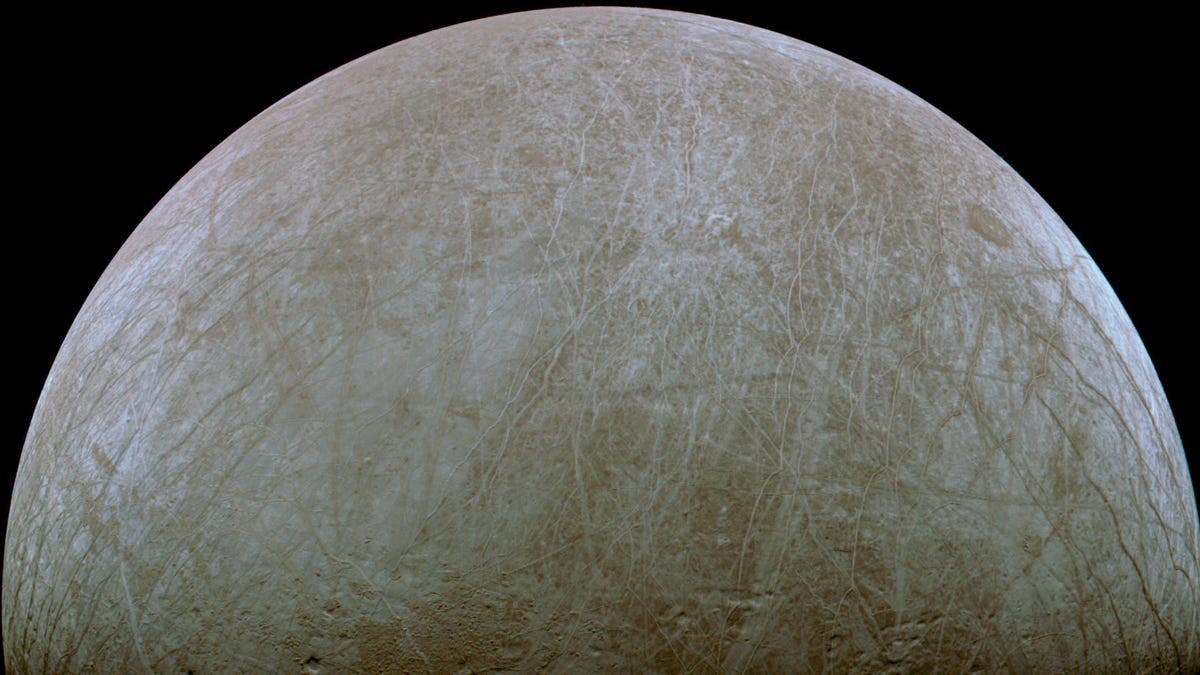
NASA’s spacecraft, Juno, captured the closest images ever taken in the last two decades of Jupiter’s moon, Europa, on Thursday, September 29th, giving us our first really good look at this ice-encrusted ocean world.
The images revealed surface features in a region near the moon’s equator called Annwn Regio during the solar-powered spacecraft’s closest approach at a distance of about 219 miles (352 kilometers).
Juno’s recent capture is the third close pass ever in history of Europa at below 310 miles (500 kilometers) altitude. It is also the closest look any spacecraft has provided of Europa since January 3, 2000, when NASA’s Galileo came within 218 miles (351 kilometers) of the surface.
Jupiter’s moon Europa slightly smaller than Earth’s Moon
Europa is the sixth-largest moon in the solar system and is slightly smaller than Earth’s moon. Amateur astronomer Stuart Atkinson revealed an early take on a broader view in a tweet on Thursday.
Worked on the Europa images taken by @NASAJuno a bit more, definitely better… 🙂 Image credit: NASA / SwRI / MSSS / S Atkinson / S Atkinson pic.twitter.com/Siluw3RwnJ
— Stuart Atkinson (@mars_stu) September 29, 2022
“The science team will be comparing the full set of images obtained by Juno with images from previous missions, looking to see if Europa’s surface features have changed over the past two decades,” Juno co-investigator Candy Hansen said in a statement.
“The JunoCam images will fill in the current geologic map, replacing existing low-resolution coverage of the area,” Hansen said.
Scientists believe a salty ocean lies below a miles-thick ice shell, sparking questions about potential conditions capable of supporting life underneath Europa’s surface, which has also been known to spit out mysterious geysers hinting at activity below the icy crust.
Juno arrived at Jupiter in 2016. The mission was extended in 2021, however, in order to specifically study some of the gas giant’s largest moons in greater detail. Ganymede has already been checked out, and Io will be looked at next year.
Besides pretty, detailed pictures, NASA’s Juno spacecraft also collected data on Europa’s composition, temperature, and atmosphere.
Juno’s observations to benefit future missions to Jovian Moon
Based on this additional data about Europa’s geology, Juno’s observations will benefit future missions to the Jovian moon, including the agency’s Europa Clipper.
Europa Clipper, which is set to launch in 2024, will study the moon’s atmosphere, surface, and interior. Its primary goal is to determine whether there are places below Europa’s surface that could support life.
As exciting as analysis on Juno’s additional data will be, the spacecraft had only a two-hour window to collect it, racing past the moon with a relative velocity of about 14.7 miles per second (23.6 kilometers per second).
“It’s very early in the process, but by all indications, Juno’s flyby of Europa was a great success,” said Scott Bolton, Juno principal investigator from Southwest Research Institute in San Antonio.
“This first picture is just a glimpse of the remarkable new science to come from Juno’s entire suite of instruments and sensors that acquired data as we skimmed over the moon’s icy crust,” he added.
The recent capture by the Juno spacecraft will fill in some of the blanks as we wait for Europa Clipper to venture out for a visit.
See all the latest news from Greece and the world at Greekreporter.com. Contact our newsroom to report an update or send your story, photos and videos. Follow GR on Google News and subscribe here to our daily email!



